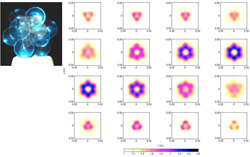
The capacity of electromagnetic waves to penetrate material bodies and interact with them constitutes the physical principle underlying the electromagnetic diagnostic techniques. These imaging methodologies allow non-contact and non-invasive characterization of morphology and electromagnetic parameters of unknown objects placed in opaque media or hidden by obstacles.
To this end, the development of appropriate methodologies for the processing of radar data, gathered by means of possibly non-canonical measurement configurations, is needed. These methodologies rely on physical / mathematical models able to describe accurately the wave / target interaction in complex scenarios, and appropriate mathematical tools for the reliable solution of the non-linear and ill-posed inverse problem, which underlines the imaging. Based on these requirements, the methodologies developed at IREA aim at providing images from which it is possible to determine the characteristic parameters of the scenario under test in a not ambiguous way.
IREA researchers have a long experience in this field, which has allowed the development of different approaches tested in different applicative contexts.
These data processing approaches are an useful diagnostic tool in a vast number of applications in which the radar imaging is of interest, including civil structures and critical infrastructure monitoring, diagnostics of cultural heritage, underground utilities mapping in urban environments, applications related to physical security, such as land mines and unexploded ordnance detection, through wall imaging, tunnel detection, detection of hidden objects on people, remote sensing of vital signs (such as breathing and heart rate).
A technological environment in which the use of these methodologies is extremely relevant is that of the ground penetrating radar (GPR), a radar system specifically designed for the imaging of buried or hidden structures. In this context, the methodologies developed at IREA, particularly those aimed at the localization and morphological characterization of unknown objects, have been successfully applied in many investigation campaigns through GPR. These were performed in the various national and international research projects which involved the exploration of archaeological sites (home of the Centaur in Pompeii, ancient Stabiae and Pontecagnano in Campania, Viggiano Lucania and many others), the monitoring of civil structures and infrastructure (eg Musmeci bridge in Potenza and different Swiss motorway courses), and the diagnostics of cultural heritage (GPR survey in the Hall of 500 in Florence in search of hidden states of the Vasari's painting).
